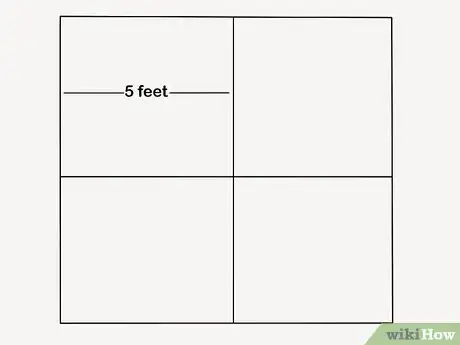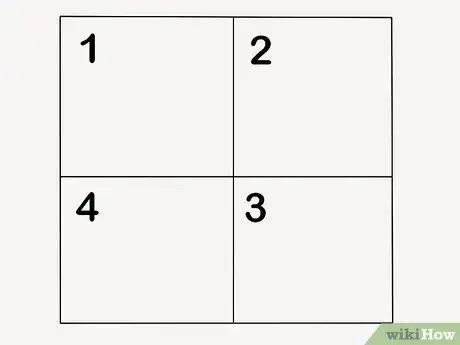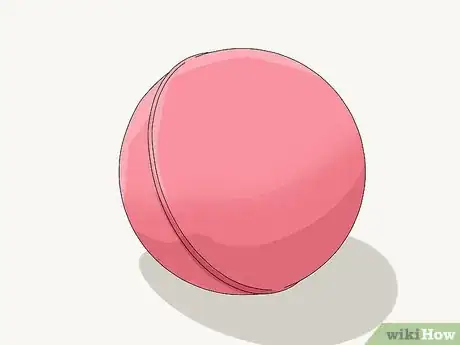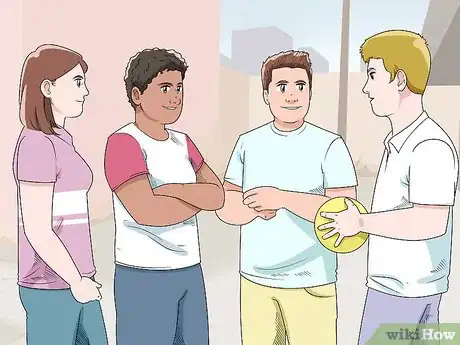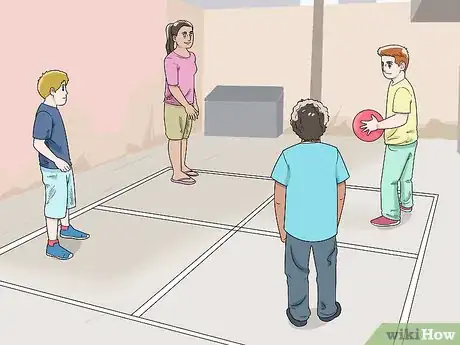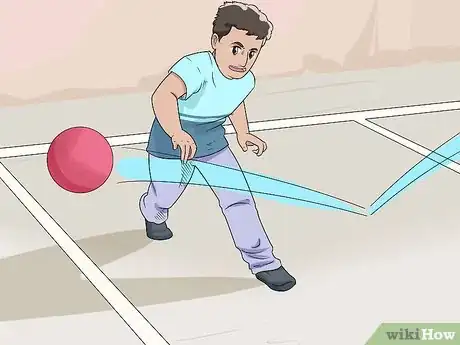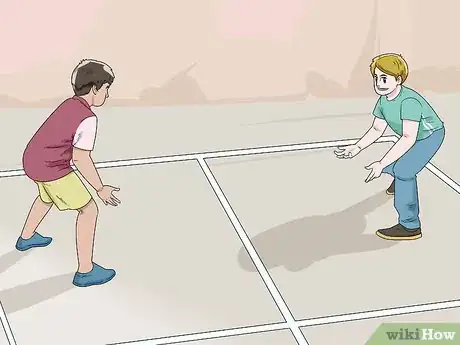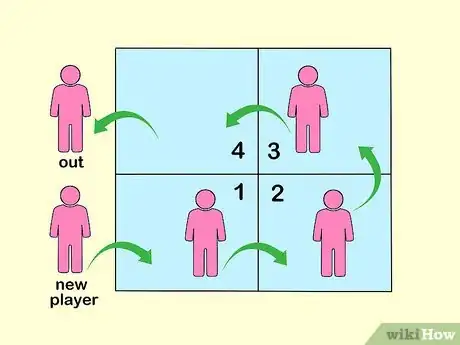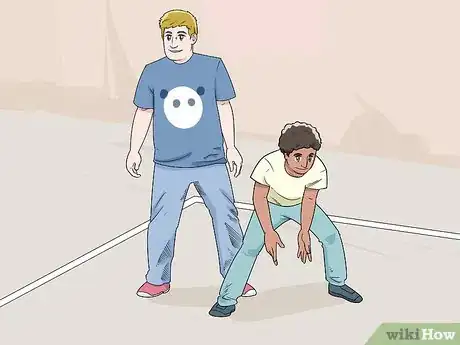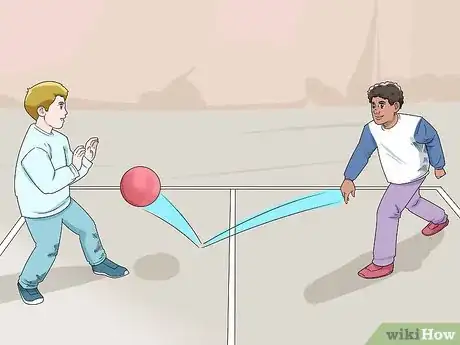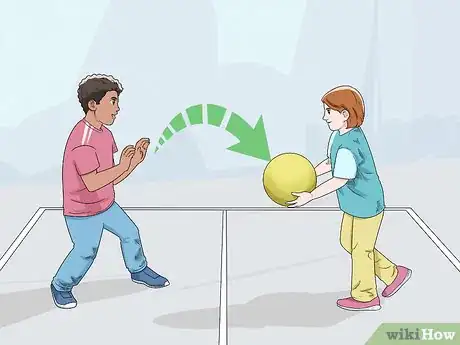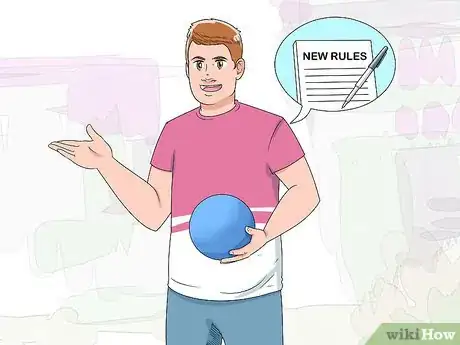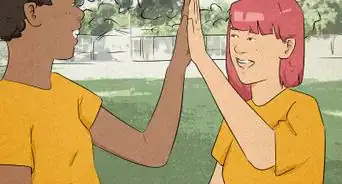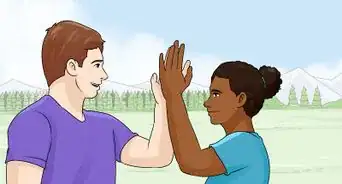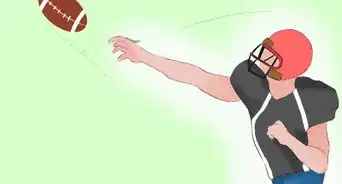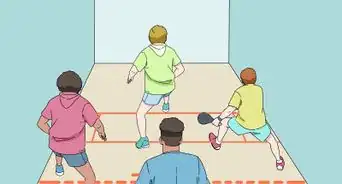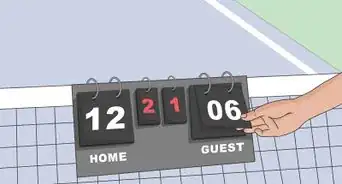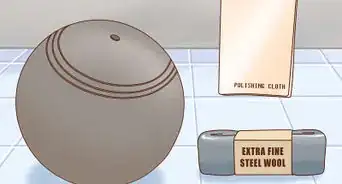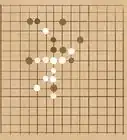This article was co-authored by wikiHow staff writer, Amy Bobinger. Amy Bobinger has been a writer and editor at wikiHow since 2017. She especially enjoys writing articles that help people overcome interpersonal hurdles but frequently covers a variety of subjects, including health and wellness, spirituality, gardening, and more. Amy graduated with a B.A. in English Lit from Mississippi College in 2011 and now lives in her hometown with her husband and two young sons.
This article has been viewed 375,249 times.
Learn more...
Four Square is a fun playground game that almost anyone can play. All you need is chalk or tape to make the squares, a ball that will bounce, and at least 4 players. Try playing with the standard rules, or mix it up for some fun!
Steps
Playing Basic Four Square
-
1Mark 4 squares on the ground. You can make the squares any size you want, but make sure you have enough room to play. Make the squares about 5 feet (1.5 m) per side for most players, although adults might enjoy the challenge from 8 feet (2.4 m) squares.[1]
-
2Number the squares from 1 to 4. The squares should be numbered clockwise starting with 1. This means the 1 and 3 squares will be diagonal from each other, as will the 2 and 4 squares.[2]
- Some people use the letters A, B, C, and D instead of numbers, while others use titles of royalty, such as Jack, Queen, King, and Ace.[3]
Advertisement -
3Use a standard rubber playground ball if you have one. This is often called a kickball and is a rubber ball about 8.5 inches (22 cm) in diameter. If you don’t have a playground ball, use any ball that’s 8–10 inches (20–25 cm) and bounces at least 50% of the height from which it was thrown.[4]
- Australian players use 3 inches (7.6 cm) felted tennis balls to play Four Square.
-
4Make sure everyone agrees on the rules before you start playing. As a "playground game" this game has spawned an incredible amount of local variations over the decades.
- If you’re playing by the standard rules, make sure everyone knows what exactly they are before starting. While often one school might have "standard rules" the new kid might think the "standard rules" are something else entirely.
- If you’re playing by variations, or if the server is allowed to make up rules during the game, make sure everyone is aware of this and agrees to it.
- Having everyone on the same page before the game starts will help prevent disputes during the game that could ruin the fun.
-
5Have a player stand in each square. The players don’t have to stay in their square the entire time, but they should stay close in order to defend their area.[5]
-
6Serve the ball from the highest-ranked square to the lowest. The server should bounce the ball once in their own square, then hit the ball so that it goes diagonally to the lowest-ranked square. The receiver can then hit the ball in any direction they choose.[6]
- Many people play Four Square so that the 4 square is the highest-ranked square, and therefore the server’s square. If this is the case, the server should stand in the 4 square and hit the ball towards the 1 square.
- Some people play the game so 1 is the highest-ranked square and 4 is the lowest. In this case, the serve would go from the 1 square towards the 4 square.
- The serve always goes in the same direction.
-
7Allow one fault for the receiver per round. After the serve, the receiver should allow the ball to bounce one time in their square, then should hit it in whatever direction they choose. If they don’t hit the ball correctly or it goes out of bounds, that is a “fault,” and one fault is allowed per round. If the receiver misses the serve twice in a round, they are eliminated.[7]
- The round lasts until a player is eliminated.
-
8Take turns hitting the ball after it bounces in your square. Once the ball is in play, whoever’s square the ball lands in should be the next to hit it. The ball is considered “in play” after someone touches it but before it lands in another square, meaning players can hit the ball in the air. You must hit the ball before it bounces a second time.[8]
-
9Hit the ball with any part of your hand but do not catch it. Players are not allowed to carry, catch, or hold the ball during play. However, they may repeatedly bounce the ball off of their hands in order to avoid breaking this rule.[11]
-
10Advance to a higher numbered square when a player is out. The goal of the game is to move up to the servers’ square. If you have more than 4 players, a new player will move into the lowest-numbered square when a player is eliminated.[12]
- If you only have 4 players, the person who is out moves to the lowest-numbered square and the other players move up, if applicable.
Playing Variations on the Game
-
1Allow young players to catch the ball for an easier version of Four Square. Younger or less-skilled players might have more fun if they can catch the ball before throwing it again.[13]
-
2Assign 2 players per square if you have 8 or more players. Play a relay-style variation of Four Square by having 2 players for each square. Whenever one player hits the ball to another square, they’ll jump out of their court and their partner will jump in.[14]
- When playing with 2 players per square, if one player is out then the team is out. If everyone agrees, however, you can adjust the rules to allow the other team member to continue playing until they are out.
-
3Hit the ball into your own square first for an Australian variation. Australian players must bounce the ball in their own square, regardless of whether the ball has already bounced in their own square. Also, in Australian Four Square the ball is allowed to touch the line.[15]
-
4Play Black Jack to get players out faster. In Black Jack, if a player can catch the ball before it lands in their square, then the person who hit the ball is out. This usually makes the game move faster.[16]
-
5Allow the server to make up special rules to keep the game changing. The server can call a rule that all of the players must follow, but it only lasts for that round. When the round is over, the server must call the rules again or else it’s assumed there are no special rules.[17]
- A special rule might be something like 7-Up, in which each player who hits the ball has to call out a number one higher than the previous player. The player who hits on the number 7, or any number that ends in 7, must skip that number or they’ll be out.[18]
- Another rule the server might call could be Underhand, in which all of the hits must be made with the back of the hand. Players should keep their hands open and their palms facing up.[19]
Community Q&A
-
QuestionCan you slam the ball into another person's square?
 Nicole ListerCommunity AnswerYes, but this is called a cherry bomb! It's usually against the rules, unless you all agree to allow it.
Nicole ListerCommunity AnswerYes, but this is called a cherry bomb! It's usually against the rules, unless you all agree to allow it. -
QuestionCan I make the square with tape?
 Community AnswerYes. Just make sure that the pieces are the same size and that the corners are about 90 degree angles.
Community AnswerYes. Just make sure that the pieces are the same size and that the corners are about 90 degree angles. -
QuestionHow do I do a cherry bomb?
 Community AnswerHold it up in the air, and throw it down as hard as you can and it bounces high. They have to hit it into another square or they are out.
Community AnswerHold it up in the air, and throw it down as hard as you can and it bounces high. They have to hit it into another square or they are out.
References
- ↑ http://www.squarefour.org/gear
- ↑ http://www.kidzworld.com/article/4776-four-square-game-rules
- ↑ http://www.squarefour.org/rules
- ↑ http://www.squarefour.org/gear
- ↑ http://www.squarefour.org/rules
- ↑ http://www.squarefour.org/rules
- ↑ http://www.squarefour.org/rules
- ↑ http://www.kidzworld.com/article/4776-four-square-game-rules
- ↑ http://www.kidzworld.com/article/4776-four-square-game-rules
- ↑ http://www.squarefour.org/rules
- ↑ http://www.squarefour.org/rules
- ↑ http://www.kidzworld.com/article/4776-four-square-game-rules
- ↑ https://www.playworks.org/game-library/foursquare/
- ↑ https://www.playworks.org/game-library/foursquare/
- ↑ http://www.squarefour.org/node/3513
- ↑ http://www.squarefour.org/coolrules
- ↑ http://www.squarefour.org/rules
- ↑ http://www.squarefour.org/coolrules
- ↑ http://www.squarefour.org/coolrules
About This Article
To play Four Square, you’ll need at least 4 players, a ball that bounces (like a kickball), and some chalk or tape. Then, find a flat, open area, like a driveway or concrete deck, and use the chalk or tape to mark 4 connected squares on the ground. Make each square about 5 feet (1.5 m) across. Then, label the squares 1, 2, 3, and 4. Each player stands in one of the squares. The player in the first square starts with the ball and serves first. The server bounces the ball once in their square, then hits it into another player’s square. That player then lets the ball bounce once in their square before hitting it into another player’s square. This continues until one player misses the ball or hits it out of bounds, called “faulting.” Each player gets one free fault per round. If they fault a second time, they’re eliminated and leave their square. When a player is eliminated, any players in a square ranked lower than theirs move up 1 square, and a new player takes the fourth square. If there are only 4 players, the eliminated player takes the fourth square. Whenever a player faults, the player in the first square serves again, and the game continues for however long everyone wants to play! For more information, including how to play Australian Four Square, read on!
